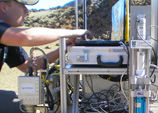Is there life on Mars?
Published: 3 October 2011
University of Glasgow ultrasonic drilling technology could help detect signs of life on the Red Planet.
Glasgow researchers have developed state-of-the-art ultrasonic drilling technology which could be used to help look for signs of life on Mars.
 The new system developed at Glasgow uses high frequency vibrations to pulverise the rock it comes into contact with. Working in collaboration with space technology company Magna Parva,the team at Glasgow have produced a high performance rock-cutting tip and space-compatible architecture.
The new system developed at Glasgow uses high frequency vibrations to pulverise the rock it comes into contact with. Working in collaboration with space technology company Magna Parva,the team at Glasgow have produced a high performance rock-cutting tip and space-compatible architecture.
Dr Patrick Harkness, a lecturer in the School of Engineering, said: "Our ultrasonic drill tool doesn't produce much heat, unlike normal rotary drills, and so it will mean that any biological material and life markers will not be damaged.
"We showed that it could drill down into samples of sandstone, pumice and basalt. Because it does not require much downwards force, it is ideal for use in low gravity environments such as Mars or on asteroids.
"We can also use it to remove a core sample, so it can be used to look for fossilised remains beneath the surface."
Dr Harkness and Chris Murray secured funding for the project from the University’s Engineering and Physical Sciences Research Council Knowledge Transfer Account and successfully participated in the recent field trials in Tenerife where their technology was fully integrated with Bridget, Astrium's exploratory space rover.
The rover is one of the lead designs that could be sent to Mars in a joint mission by NASA and the European Space Agency.
*Thanks to the Telegraph for permission to publish quotes from their original article: 'Space rover prepares for Mars in Tenerife tests'.
Related pages
- Dr Patrick Harkness
- Professor Margaret Lucas
- Space Glasgow
- School of Engineering
- Bridget rover field trials
- Magna Parva
- Telegraph: Space rover prepared for Mars in Tenerife tests: video and coverage
First published: 3 October 2011
<< News

